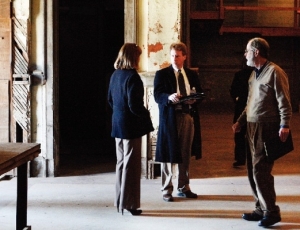Experts take look at Goldsboro's plan for renovated train station
By Catharin Shepard
Published in News on March 5, 2009 1:46 PM

News-Argus/MITCH LOEBER
Architects and engineers meet with a Downtown Goldsboro Development Corp. representative at Union Station Wednesday for their first look at the work to be done on the revitalization and restoration project.
There are ghost marks on the walls of Union Station.
But far from indicating any sort of paranormal activity, these indicators show where old structures like posts and stairs used to be, before they were removed or rotted away, explained Raleigh architect Jim Smith.
About a dozen architects got a sneak peek at Union Station Wednesday morning in an exclusive open house-style showing of the ongoing project. Firms from as far away as Michigan, Pennsylvania, Texas and even India have expressed interest in handling the restoration, and the Downtown Goldsboro Development Corp. invited 25 firms to have an informal first look inside the building before beginning the selection process.
"It's fantastic. It's not as bad as some I've seen," Smith said. "It's a shame the building supply company damaged it so much."
The company used the station for storage for many years, but now Union Station is already on its way to restoration.
"Whoever did the stabilization did a pretty good job," said Kurt Eichenberger, from Raleigh, looking around the second floor.
Chicken wire, most definitely not an original feature, gleamed from the roof overhangs. The wire is part of the safety and protective precautions taken to prevent debris from falling and injuring anyone, and to help preserve the existing structure as much as possible.
Despite the intrusion of the necessary stabilization efforts, including support beams, a scaffolding mezzanine and a two-by-four staircase, to the eyes of a professional architect, the station has many stories to tell.
The pipes are long gone, but one back corner of the building, sunk deep into the floor, could have been a boiler room. A hole carved into the wall at about waist-height was likely a crawl space. One area once featured a freight elevator. The second floor held even more interesting nooks and crannies.
"There's a room right above there that looks like it may have been a dispatcher's office," said Smith. "It's one of the few finished rooms on this level."
The patterning of the floor downstairs pointed toward a pit, sectioned off with wooden beams, where the floor joists had fallen in. Termites, most likely, the architects agreed, though water damage could also have played a part in causing the damage.
The long-gone space was probably once a ticket counter, and judging by the time and place it was built, there might have been two windows. It was a duality often seen in old public buildings in the South that were constructed before desegregation, Smith said.
Even the smaller details, like the coffered ceiling with "dentals" -- small, square protrusions around the edges -- are of historical value, helping to date the station. The windows above some of the doors, called transom windows, still have a few original, unbroken panes of glass. The "operators," long sticks attached to the upper windows, are also still in place, as if waiting for someone to come along and let in the light.
"It's pretty cool. It's delightful to find an old building this way," Smith said. "It's very worthy of restoration. It'll be a showplace for Goldsboro."
Architect Steve Schuster of Clearscapes in Raleigh also believes there is a positive outlook for the station.
"It's a spectacular building, there's no question of that," he said.
And even more spectacular is that this is one historic train station that won't be turned into a restaurant or shopping center, he added.
Officials hope to use the station as a multi-modal transportation hub, offering passenger service from Amtrack, GATEWAY and possibly even the Greyhound bus line.
"What's even more important is the city of Goldsboro is going to use it for its intended purpose," Schuster said. "Even in a soft economy, it's working in this town."
And to local architect James T. Vinson, who grew up in Goldsboro, seeing Union Station returned to its early glory has special meaning.
"It would mean a lot to me to see it restored," Vinson said. "I think it would be absolutely beautiful."
The next stage in the lengthy process will be selecting an architect to do the work on Union Station, said DCDG representative Jennifer Sumler. The call for letters of interest will go out soon, and the selection process will proceed from there.
"It's the first step," she said.
